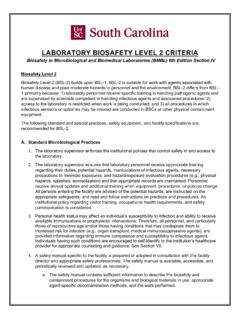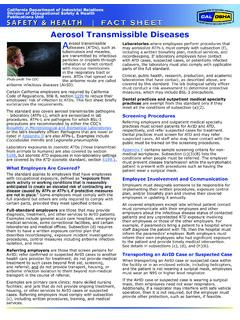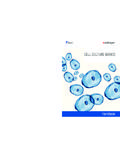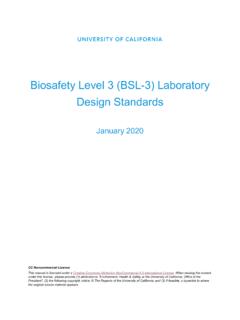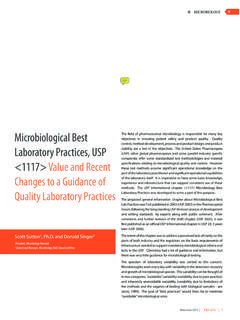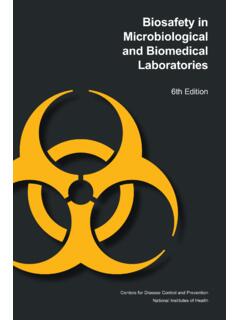Transcription of Standard Safety Practices in the Microbiology Laboratory
1 Laboratory Safety |163 Laboratorians working with infectious agents are subject to Laboratory -acquiredinfections as a result of accidents or unrecognized incidents. The degree ofhazard depends upon the virulence of the biological agent concerned and hostresistance. Laboratory -acquired infections occur when microorganisms areinadvertently ingested, inhaled, or introduced into the tissues. Laboratorians arerelatively safe when working with Haemophilus influenzae andStreptococcuspneumoniae;however, persons who work with aerosolizedNeisseria meningitidisare at increased risk of acquiring a meningococcal infection. The primarylaboratory hazard associated with enteric pathogens such as Shigella, Vibrio orSalmonellais accidental ingestion.
2 biosafety Level 2 (BSL-2) Practices are suitablefor work involving these agents that present a moderate potential hazard topersonnel and the environment. The following requirements have been establishedfor laboratorians working in BSL-2 facilities. Laboratory personnel must receive specific training in handling pathogenicagents and be directed by competent scientists. Access to the Laboratory must be limited when work is being conducted. Extreme precautions must be taken with contaminated sharp items. Certain procedures involving the creation of infectious aerosols or splashes mustbe conducted by personnel who are wearing protective clothing and microbiological Safety practicesThe following Safety guidelines listed below apply to all Microbiology laboratories ,regardless of biosafety access to laboratorySometimes, people who do not work in the Laboratory attempt to enter thelaboratory to look for test results they desire.
3 Although this occurs more frequentlyin clinical laboratories , access to the Laboratory should be limited, regardless of Safety Practices in the Microbiology LaboratoryAPPENDIX 1164|Manual for Identification and Antimicrobial Susceptibility TestingBiohazard signs or stickers should be posted near all Laboratory doors and on allequipment used for Laboratory work ( ,incubators, hoods, refrigerators, andfreezers). Children under 12 years of age and pets are not allowed in laboratoryareas. All laboratories should be locked when not in use. In addition, all freezersand refrigerators located in corridors should be Laboratory should contain a sink for handwashing. Hands should be washedfor at least one minute.
4 Frequent handwashing is one of the most effectiveprocedures for avoiding Laboratory -acquired infections. Hands should be washedwith an appropriate germicidal soap before exiting the Laboratory and afterinfectious materials are handled. (Laboratorians working with gram-positiveorganisms should use alcohol (70%) to cleanse their hands if germicidal soap isunavailable.)EatingEating, drinking, and smoking are not permitted in Laboratory work areas. Foodmust be stored and eaten outside of the work area in designated areas used for thatpurpose only. Personal articles ( , handbags, eyeglasses, or wallets) should not beplaced on the pipettingMouth pipetting is strictly prohibitedin the Laboratory . Rubber bulbs ormechanical devices should be high degree of precaution must always be taken with any contaminated sharpitems, including needles and syringes, slides,pipettes, capillary tubes, and of sharps in designated containers.
5 To minimize finger sticks, useddisposable needles must not be bent, sheared, broken, recapped, removed from disposable syringes, or otherwise manipulated by hand before sharps, including syringes, should be placed in a labeled discardpan for decontamination before cleaning. Broken glassware should not be handleddirectly by hand but should be removed by mechanical means ( ,a brush anddustpan, tongs, or forceps).Aerosols All procedures must be carefully performed to minimize splashes or that tend to produce aerosols should be avoided. Inoculating wires andLaboratory Safety |165loops should be cooled by holding them still in the air for 5 10 seconds beforethey touch colonies or clinical material. Loops containing infectious materialshould be dried in the hot air above a burner before flaming.
6 Vortexing andcentrifugation should be done in closed containers. (If Safety capped tubes are notavailable, sealed tubes should be used.) Gauze should be used to remove the topson blood specimens and should be placed around the top of blood culture bottlesto minimize aerosol production during removal of the needle. Needles shouldnever be cut or removed from the syringe before autoclaving. All body fluidsshould be centrifuged in carriers with Safety caps procedures with a high potential for creating infectious aerosols areconducted or when a procedure is used that can result in splashing or spraying ofthe face with infectious or other hazardous materials, Laboratory work should beconducted in a Safety cabinet or by laboratorians wearing the appropriate face-protection equipment ( ,goggles, mask, face shield, or other splatter guards).
7 Procedures that pose a risk may include centrifuging, grinding, blending, vigorousshaking or mixing, sonic disruption, opening containers of infectious materialswhose internal pressures may be different from ambient pressures, inoculatinganimals intranasally, and harvesting infected tissues from animals or eggs. Faceprotection should also be used when working with high concentrations or largevolumes of infectious bench tops and other surfaces Bench tops should be wiped with a disinfectant (a phenolic disinfectant, 1%sodium hypochlorite [bleach], or 70% isopropyl alcohol) routinely after workingwith infectious agents or clinical specimens or after spills, splashes, or other contamination by infectious materials.
8 Solutions of disinfectants should bemaintained at the work station (see Disinfectants).Disposal of contaminated materialsAll discarded plates, tubes, clinical samples, and other contaminated materialsshould be placed in disposal containers at each bench. Special disposal boxes mustbe used for sharps ( ,syringes or broken glass) to minimize the risk of overfilling such containers. Containers of contaminated material should becarefully transported to the autoclave room and autoclaved before autoclave must be available for the BSL-2/3 Laboratory and must be operatedonly by personnel who have been properly trained in its use. To verify that eachautoclave is working properly, spore strips or other biological indicators designedto test for efficiency of sterilization should be included in autoclave loads on a166|Manual for Identification and Antimicrobial Susceptibility Testingregular basis.
9 Each autoclave load should be monitored with temperature-sensitivetape, thermograph, or by other means ( ,biological indicators).General Laboratory policiesAll areas of the Laboratory must be kept clean and orderly. Dirt, dust, crowding, orclutter is a Safety hazard and is not consistent with acceptable biological should be kept clean and free of unnecessary clutter. They should be washedwith a germicidal solution on a regular basis and after any spill of infectiousmaterial has and freezersRefrigerators and freezers should be regularly inspected for the presence of brokenvials or tubes containing infectious agents. When removing and discarding brokenmaterial, laboratorians should wear gloves and proper protective attire ( , Laboratory coat, goggles, or face-shield).
10 Refrigerators and freezers should beregularly cleaned with a disinfectant and defrosted to prevent possiblecontamination and temperature preventionBurners should be used away from lamps and flammable materials. Bulkflammable material must be stored in the Safety cabinet. Small amounts of theseflammable materials ( ,ethyl acetate, ethyl alcohol, and methanol) can be storedin Safety containers. Burners must be turned off when not in use. All laboratoriansmust know the location of fire extinguishers, fire blankets, and showers, and firesafety instructions and evacuation routes should be practicesTranspor t of biohazardous materialsTransport of biohazardous materials from one building to another increases therisk of breakage and spills.










